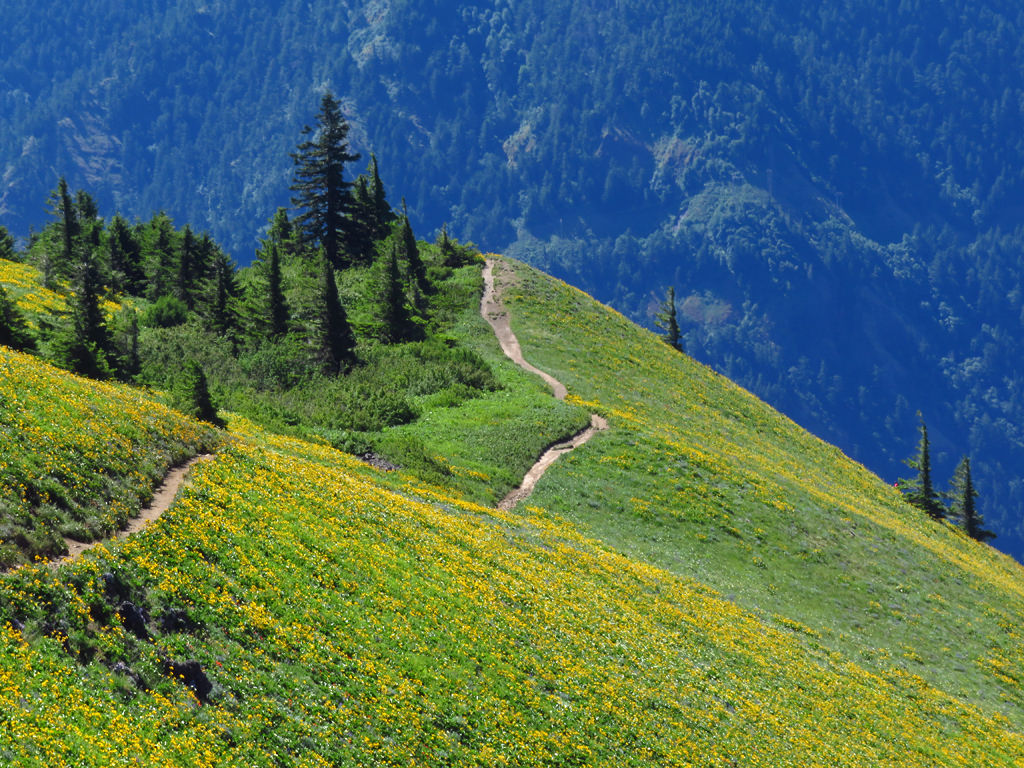Over the summer, a wildfire ravaged nearly 50,000 acres of the Columbia River Gorge. It will be months, if not years, before some of the area’s best-loved hikes reopen. And even when they do, the Gorge’s celebrated viewpoints of the 4,000-foot-deep canyon through the Cascade Mountains won’t look quite the same.
But if you need your Gorge fix while restoration work continues in Oregon, there’s good news: The Washington side of the Gorge, just north of the Columbia River, remains mostly unscathed. Renee Tkach, project manager for the Gorge Towns to Trail effort at Friends of the Columbia Gorge, says the Washington side offers a change of pace. “The Washington side is slower,” she says. “It’s a little more of a step back in time.”
Here are five hikes for exploring the Washington side of the Columbia River Gorge.
Cape Horn Loop
Survey the damage done by the Eagle Creek Fire along the Cape Horn Loop. Numerous vantage points along the lower portion of the trail reveal sweeping views of the western edge of the Gorge, where large swaths of charred snags remain amongst the blankets of fir trees for which the region is known.
If you’re looking to cheer up, the 7-mile Cape Horn Loop offers plenty to love in its own right: Hikers on the upper portion of the trail trek through thick forests of bigleaf maple trees and pastoral meadows—Tkach calls it “one of the most amazing fall hikes,” due to the colorful maple trees along the way—while the lower section shows off the cascading Cape Horn Falls.
Three Corner Rock
If the crowded parking lots at Dog Mountain and Cape Horn fill you with dread, head north from the Columbia River and check out the comparatively empty Three Corner Rock hike.
You’ll earn your post-hike beer—the trail gains 3,200 feet over 8.6 miles—but we think you’ll find the hidden scenery worth the effort. Most of the trail hovers under a forest canopy, but other natural features abound. “You go along this beautiful rock creek, and there are all kinds of little waterfalls as you make your way up there,” Tkach says.
The trail ends at Three Corner Rock, where you’ll enjoy 360-degree views of Mount Hood, Mount St. Helens, Mount Jefferson, and other Cascade peaks.
Dog Mountain
No bucket list of Gorge hikes is complete without a nod to Dog Mountain. Even with 2,800 feet of elevation gain over roughly 3 miles, Dog Mountain attracts hikers by the hundreds every spring, due largely to its stunning wildflower blossoms. Bright yellow balsamroot covers much of the mountainside every May and June, with violet lupine adding to Mother Nature’s electric palette.

Tackle the trek in mid- or late-October, though, and you may not encounter another hiker. “It doesn’t need to be hiked for only one month of the year,” Tkach says. “It’s a great place to go in the fall.”
What it lacks in blossoms, Dog Mountain makes up for with wide-open views. Sweeping vistas of Mount Hood and Mount St. Helens await tenacious hikers at the summit, and the meadow makes an ideal lunch stop—assuming the weather cooperates (pack layers in case it doesn’t).
Lyle Cherry Orchard
If another week of rain has you jonesing for sun, head a little further east to the Lyle Cherry Orchard, some 80 miles east of downtown Portland. As Tkach puts it: “When it’s raining in Portland and you’re about ready to lose it because you haven’t seen the sun in weeks, it’s typically going to be sunny there.”
You’ll gain about 1,500 feet of elevation over 2.5 miles, hiking through oak groves and cherry orchards along the way. “It’s more of the smaller, more twisted and configured oaks, and it’s beautiful starting in the fall, when the leaves are changing,” Tkach says. “And when the leaves fall, it’s a magical forest.”
When you arrive at the summit, you’ll enjoy views of The Dalles, Rowena Crest, and the wider Gorge region.
With a south-facing slope and predisposition for sunny days, Lyle Cherry Orchard remains accessible most of the winter, if not all year long. In fact, Tkach recommends tackling the hike in January—and pairing your trek with a stop at Cor Cellars, which hosts a tasting room at the mouth of the Klickitat River. The views are beautiful any time of year, but January is peak mating season for bald eagles, and Tkach says that visitors can even see them from the winery.
Catherine Creek
Nestled near the eastern end of the Columbia River Gorge, the Catherine Creek network of trails sits at the confluence of two distinct ecosystems: Once you’ve ascended to a ridgeline overlooking the Gorge, you’ll see arid, khaki-colored rock formations to the East—and verdant forests and miles of green hillsides to the West.
Not just that, but you’ll barely break a sweat in enjoying those views.
The most popular loop starts Old Highway 8, passes a rickety wooden homestead, offers views of a dramatic natural arch cleaved into the hillside, and ascends roughly 750 feet onto a wide-open meadow. From here, hikers can choose among a wide swath of interconnected trails, few of which ever leave the hillside.
Much like the nearby Lyle Cherry Orchard, Catherine Creek remains (mostly) snow-free and accessible all year long—and the area’s popular wildflower displays may bloom as early as January.
